SNMP的配置
h3c交换机snmp配置、h3c交换机开启snmp、h3csnmp配置实例
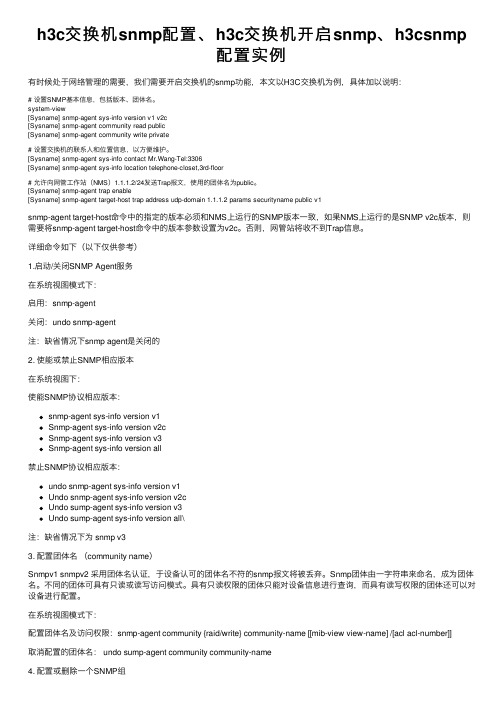
h3c交换机snmp配置、h3c交换机开启snmp、h3csnmp配置实例有时候处于⽹络管理的需要,我们需要开启交换机的snmp功能,本⽂以H3C交换机为例,具体加以说明:# 设置SNMP基本信息,包括版本、团体名。
system-view[Sysname] snmp-agent sys-info version v1 v2c[Sysname] snmp-agent community read public[Sysname] snmp-agent community write private# 设置交换机的联系⼈和位置信息,以⽅便维护。
[Sysname] snmp-agent sys-info contact Mr.Wang-Tel:3306[Sysname] snmp-agent sys-info location telephone-closet,3rd-floor# 允许向⽹管⼯作站(NMS)1.1.1.2/24发送Trap报⽂,使⽤的团体名为public。
[Sysname] snmp-agent trap enable[Sysname] snmp-agent target-host trap address udp-domain 1.1.1.2 params securityname public v1snmp-agent target-host命令中的指定的版本必须和NMS上运⾏的SNMP版本⼀致,如果NMS上运⾏的是SNMP v2c版本,则需要将snmp-agent target-host命令中的版本参数设置为v2c。
否则,⽹管站将收不到Trap信息。
详细命令如下(以下仅供参考)1.启动/关闭SNMP Agent服务在系统视图模式下:启⽤:snmp-agent关闭:undo snmp-agent注:缺省情况下snmp agent是关闭的2. 使能或禁⽌SNMP相应版本在系统视图下:使能SNMP协议相应版本:snmp-agent sys-info version v1Snmp-agent sys-info version v2cSnmp-agent sys-info version v3Snmp-agent sys-info version all禁⽌SNMP协议相应版本:undo snmp-agent sys-info version v1Undo snmp-agent sys-info version v2cUndo sump-agent sys-info version v3Undo sump-agent sys-info version all\注:缺省情况下为 snmp v33. 配置团体名(community name)Snmpv1 snmpv2 采⽤团体名认证,于设备认可的团体名不符的snmp报⽂将被丢弃。
SNMP的安全性配置
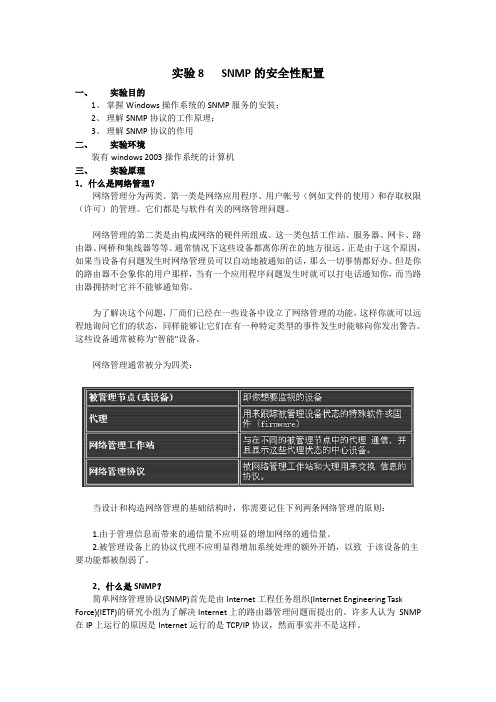
实验8 SNMP的安全性配置一、实验目的1、掌握Windows操作系统的SNMP服务的安装;2、理解SNMP协议的工作原理;3、理解SNMP协议的作用二、实验环境装有windows 2003操作系统的计算机三、实验原理1.什么是网络管理?网络管理分为两类。
第一类是网络应用程序、用户帐号(例如文件的使用)和存取权限(许可)的管理。
它们都是与软件有关的网络管理问题。
网络管理的第二类是由构成网络的硬件所组成。
这一类包括工作站、服务器、网卡、路由器、网桥和集线器等等。
通常情况下这些设备都离你所在的地方很远。
正是由于这个原因,如果当设备有问题发生时网络管理员可以自动地被通知的话,那么一切事情都好办。
但是你的路由器不会象你的用户那样,当有一个应用程序问题发生时就可以打电话通知你,而当路由器拥挤时它并不能够通知你。
为了解决这个问题,厂商们已经在一些设备中设立了网络管理的功能,这样你就可以远程地询问它们的状态,同样能够让它们在有一种特定类型的事件发生时能够向你发出警告。
这些设备通常被称为"智能"设备。
网络管理通常被分为四类:当设计和构造网络管理的基础结构时,你需要记住下列两条网络管理的原则:1.由于管理信息而带来的通信量不应明显的增加网络的通信量。
2.被管理设备上的协议代理不应明显得增加系统处理的额外开销,以致于该设备的主要功能都被削弱了。
2.什么是SNMP?简单网络管理协议(SNMP)首先是由Internet工程任务组织(Internet Engineering Task Force)(IETF)的研究小组为了解决Internet上的路由器管理问题而提出的。
许多人认为SNMP 在IP上运行的原因是Internet运行的是TCP/IP协议,然而事实并不是这样。
SNMP被设计成与协议无关,所以它可以在IP,IPX,AppleTalk,OSI以及其他用到的传输协议上被使用。
SNMP是一系列协议组和规范(见下表),它们提供了一种从网络上的设备中收集网络管理信息的方法。
如何设置路由器SNMP
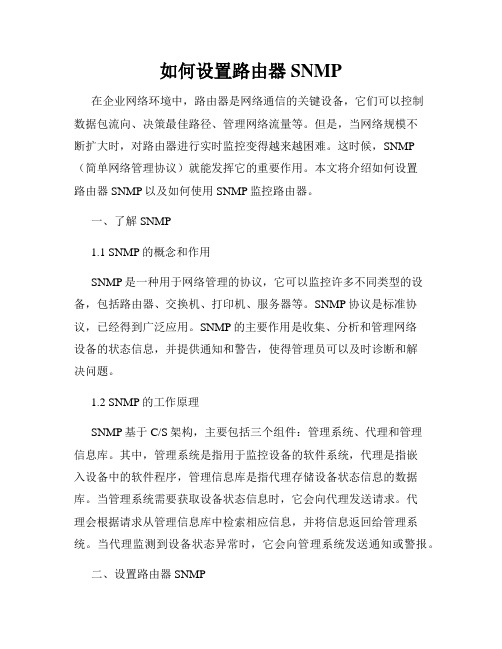
如何设置路由器SNMP在企业网络环境中,路由器是网络通信的关键设备,它们可以控制数据包流向、决策最佳路径、管理网络流量等。
但是,当网络规模不断扩大时,对路由器进行实时监控变得越来越困难。
这时候,SNMP (简单网络管理协议)就能发挥它的重要作用。
本文将介绍如何设置路由器SNMP以及如何使用SNMP监控路由器。
一、了解SNMP1.1 SNMP的概念和作用SNMP是一种用于网络管理的协议,它可以监控许多不同类型的设备,包括路由器、交换机、打印机、服务器等。
SNMP协议是标准协议,已经得到广泛应用。
SNMP的主要作用是收集、分析和管理网络设备的状态信息,并提供通知和警告,使得管理员可以及时诊断和解决问题。
1.2 SNMP的工作原理SNMP基于C/S架构,主要包括三个组件:管理系统、代理和管理信息库。
其中,管理系统是指用于监控设备的软件系统,代理是指嵌入设备中的软件程序,管理信息库是指代理存储设备状态信息的数据库。
当管理系统需要获取设备状态信息时,它会向代理发送请求。
代理会根据请求从管理信息库中检索相应信息,并将信息返回给管理系统。
当代理监测到设备状态异常时,它会向管理系统发送通知或警报。
二、设置路由器SNMP2.1 收集路由器信息在设置路由器SNMP之前,需要先收集路由器信息。
可以通过以下命令在路由器上收集信息:show version # 显示路由器版本信息show running-config # 显示当前路由器配置信息show snmp # 显示SNMP配置信息此外,可以在路由器的官方网站上找到SNMP相关的文档和配置指南。
2.2 配置SNMP配置路由器SNMP需要设置SNMP版本、SNMP团体字符串和SNMP管理系统IP地址。
SNMP版本可以设置为SNMPv2c或SNMPv3。
SNMP团体字符串是一种安全特性,用于确保只有获得该字符串的SNMP管理系统才能访问设备。
SNMP管理系统IP地址是指用于获取设备状态信息的计算机的IP地址。
SNMP的配置

SNMP配置1.1概述SNMP是Simple Network Manger Protocol(简单网络管理协议)的缩写,在1988年8月就成为一个网络管理标准RFC1157。
到目前,因众多厂家对该协议的支持,SNMP已成为事实上的网管标准,适合于在多厂家系统的互连环境中使用。
利用SNMP协议,网络管理员可以对网络上的节点进行信息查询、网络配置、故障定位、容量规划,网络监控和管理是SNMP的基本功能。
SNMP是一个应用层协议,为客户机/服务器模式,包括三个部分:z SNMP网络管理器z SNMP代理z MIB管理信息库SNMP网络管理器,是采用SNMP来对网络进行控制和监控的系统,也称为NMS(Network Management System)。
常用的运行在NMS上的网管平台有HPOpenView 、CiscoView、CiscoWorks 2000,锐捷网络针对自己的网络设备,开发了一套网管软件--Star View。
这些常用的网管软件可以方便的对网络设备进行监控和管理。
SNMP代理(SNMP Agent)是运行在被管理设备上的软件,负责接受、处理并且响应来自NMS的监控和控制报文,也可以主动发送一些消息报文给NMS。
NMS和Agent的关系可以用如下的图来表示:图1 网络管理站(NMS)与网管代理(Agent)的关系图MIB(Management Information Base)是一个虚拟的网络管理信息库。
被管理的网络设备中包含了大量的信息,为了能够在SNMP报文中唯一的标识某个特定的管理单元,MIB采用树形层次结构来描述网络设备中的管理单元。
树的节点表示某个特定的管理单元。
如下图MIB对象命名树,为了唯一标识网络设备中的某个管理单元System,可以采用一串的数字来表示,如{1.3.6.1.2.1.1}这一串数字即为管理单元的Object Identifier(单元标识符),MIB则是网络设备的单元标识符的集合。
SNMP的配置
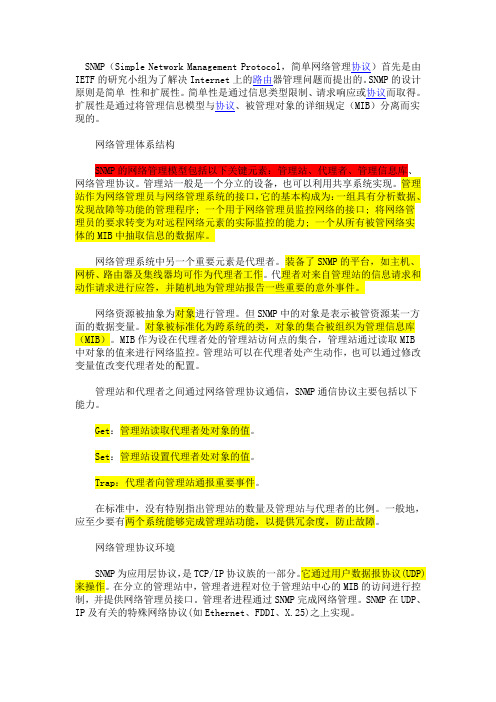
SNMP(Simple Network Management Protocol,简单网络管理协议)首先是由IETF的研究小组为了解决Internet上的路由器管理问题而提出的。
SNMP的设计原则是简单性和扩展性。
简单性是通过信息类型限制、请求响应或协议而取得。
扩展性是通过将管理信息模型与协议、被管理对象的详细规定(MIB)分离而实现的。
网络管理体系结构SNMP的网络管理模型包括以下关键元素:管理站、代理者、管理信息库、网络管理协议。
管理站一般是一个分立的设备,也可以利用共享系统实现。
管理站作为网络管理员与网络管理系统的接口,它的基本构成为:一组具有分析数据、发现故障等功能的管理程序; 一个用于网络管理员监控网络的接口; 将网络管理员的要求转变为对远程网络元素的实际监控的能力; 一个从所有被管网络实体的MIB中抽取信息的数据库。
网络管理系统中另一个重要元素是代理者。
装备了SNMP的平台,如主机、网桥、路由器及集线器均可作为代理者工作。
代理者对来自管理站的信息请求和动作请求进行应答,并随机地为管理站报告一些重要的意外事件。
网络资源被抽象为对象进行管理。
但SNMP中的对象是表示被管资源某一方面的数据变量。
对象被标准化为跨系统的类,对象的集合被组织为管理信息库(MIB)。
MIB作为设在代理者处的管理站访问点的集合,管理站通过读取MIB中对象的值来进行网络监控。
管理站可以在代理者处产生动作,也可以通过修改变量值改变代理者处的配置。
管理站和代理者之间通过网络管理协议通信,SNMP通信协议主要包括以下能力。
Get:管理站读取代理者处对象的值。
Set:管理站设置代理者处对象的值。
Trap:代理者向管理站通报重要事件。
在标准中,没有特别指出管理站的数量及管理站与代理者的比例。
一般地,应至少要有两个系统能够完成管理站功能,以提供冗余度,防止故障。
网络管理协议环境SNMP为应用层协议,是TCP/IP协议族的一部分。
它通过用户数据报协议(UDP)来操作。
SNMPSYSLOG配置说明
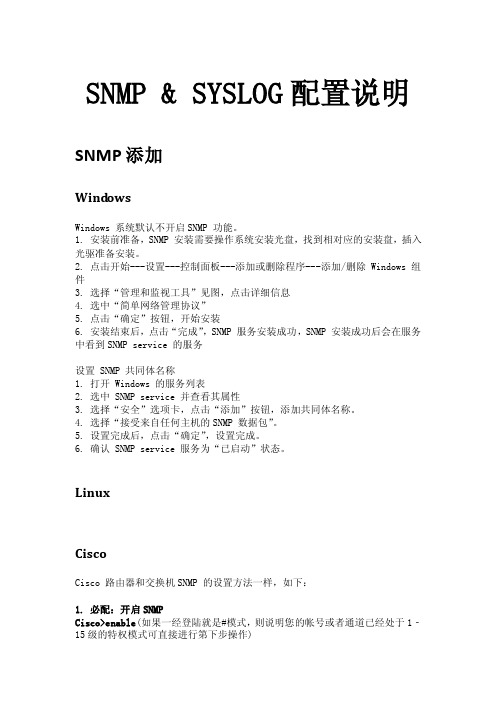
SNMP & SYSLOG配置说明SNMP添加Wind owsWindows 系统默认不开启SNMP 功能。
1. 安装前准备,SNMP 安装需要操作系统安装光盘,找到相对应的安装盘,插入光驱准备安装。
2. 点击开始---设置---控制面板---添加或删除程序---添加/删除Windows 组件3. 选择“管理和监视工具”见图,点击详细信息4. 选中“简单网络管理协议”5. 点击“确定”按钮,开始安装6. 安装结束后,点击“完成”,SNMP 服务安装成功,SNMP 安装成功后会在服务中看到SNMP service 的服务设置 SNMP 共同体名称1. 打开 Windows 的服务列表2. 选中 SNMP service 并查看其属性3. 选择“安全”选项卡,点击“添加”按钮,添加共同体名称。
4. 选择“接受来自任何主机的SNMP 数据包”。
5. 设置完成后,点击“确定”,设置完成。
6. 确认 SNMP service 服务为“已启动”状态。
LinuxCiscoCisco 路由器和交换机SNMP 的设置方法一样,如下:1. 必配:开启SNMPCisco>enable(如果一经登陆就是#模式,则说明您的帐号或者通道已经处于1‐15级的特权模式可直接进行第下步操作)Cisco#configure terminalCisco(config)#SNMPserver community CNS ro (配置SNMP 团体名为cns,ro 为读权限)Cisco(config)#SNMPserver community NI rw(配置SNMP 团体名为NI,rw 为写权限)Cisco(config)#exitCisco# copy run startup(保存命令,如保存不了请利用show process memory 命令查看内存是否已满。
)Cisco#exitCisco>exit2. 选配:开启SNMP TrapCisco>enable(如果一经登陆就是#模式,则说明您的帐号或者通道已经处于1‐15级的特权模式可直接进行第下步操作)Cisco#configure terminalCisco(config)#SNMPserver community ChinaNetwork ro (配置本路由器\交换机的只读字串ChinaNetwork)Cisco(config)#SNMPserver community ChinaNetwork rw (配置本路由器\交换机的读写字串ChinaNetwork)Cisco(config)#SNMPserver enable traps (允许设备将所有类型SNMP Trap 发送出去)Cisco(config)#SNMPserver host 1.1.1.1 traps trapcomm (指定设备SNMP Trap 的接收者为1.1.1.1,发送Trap 时采用trapcomm 作为字串)Cisco(config)#SNMPserver trapsource interfacetype fastethernet 0/0 (指定发送trap 信息的源IP 地址为fastethernet 0/0 接口的地址)Cisco# copy run startup (保存命令,如保存不了请利用show process memory 命令查看内存是否已满。
基于SNMP的网络管理软件的配置与使用
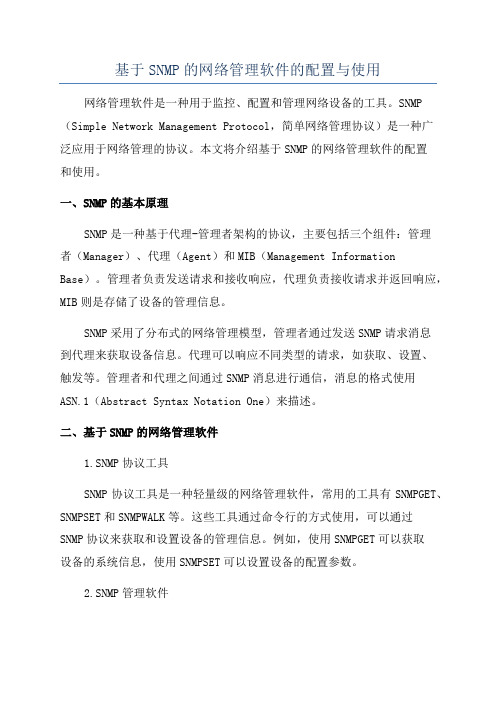
基于SNMP的网络管理软件的配置与使用网络管理软件是一种用于监控、配置和管理网络设备的工具。
SNMP (Simple Network Management Protocol,简单网络管理协议)是一种广泛应用于网络管理的协议。
本文将介绍基于SNMP的网络管理软件的配置和使用。
一、SNMP的基本原理SNMP是一种基于代理-管理者架构的协议,主要包括三个组件:管理者(Manager)、代理(Agent)和MIB(Management Information Base)。
管理者负责发送请求和接收响应,代理负责接收请求并返回响应,MIB则是存储了设备的管理信息。
SNMP采用了分布式的网络管理模型,管理者通过发送SNMP请求消息到代理来获取设备信息。
代理可以响应不同类型的请求,如获取、设置、触发等。
管理者和代理之间通过SNMP消息进行通信,消息的格式使用ASN.1(Abstract Syntax Notation One)来描述。
二、基于SNMP的网络管理软件1.SNMP协议工具SNMP协议工具是一种轻量级的网络管理软件,常用的工具有SNMPGET、SNMPSET和SNMPWALK等。
这些工具通过命令行的方式使用,可以通过SNMP协议来获取和设置设备的管理信息。
例如,使用SNMPGET可以获取设备的系统信息,使用SNMPSET可以设置设备的配置参数。
2.SNMP管理软件SNMP管理软件是一种图形化的网络管理工具,提供了可视化的界面和丰富的功能。
常见的SNMP管理软件有Zabbix、Cacti和SNMPc等。
这些软件可以通过SNMP协议来监控网络设备的状态、性能和配置信息,同时也可以进行告警、日志和报表等功能。
3.SNMP代理软件SNMP代理软件是一种用于模拟设备的网络管理工具,可以模拟出SNMP代理的功能。
常见的SNMP代理软件有Net-SNMP、SNMP Agent Simulator和SNMP Simulator等。
SNMP配置手册
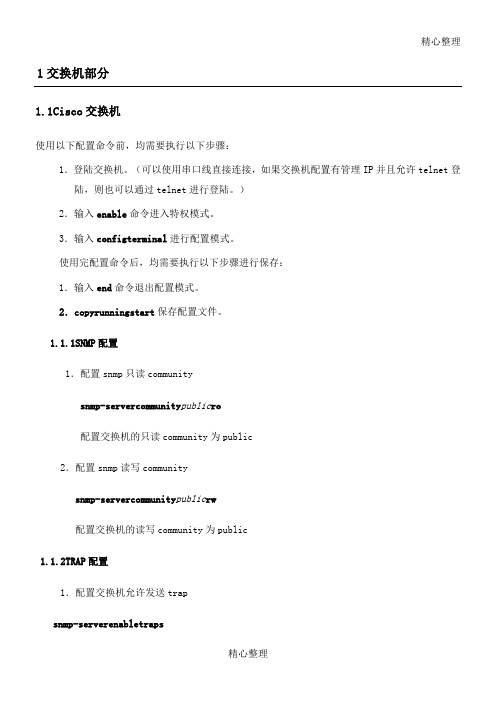
精心整理1交换机部分1.1Cisco交换机使用以下配置命令前,均需要执行以下步骤:1.登陆交换机。
(可以使用串口线直接连接,如果交换机配置有管理IP并且允许telnet登陆,则也可以通过telnet进行登陆。
)231212配置交换机的读写community为public1.1.2TRAP配置1.配置交换机允许发送trapsnmp-serverenabletraps2.配置交换机接收trap的主机snmp-serverhosttraps public指定交换机SNMPTrap的接收者为,发送Trap时采用public作为字串1.1.3Syslog配置1.打开交换机的syslog功能2.341.21登2.输入system命令进入配置模式。
使用完配置命令后,均需要执行以下步骤进行保存:1.输入return命令退出配置模式。
2.Save保存配置文件。
1.2.1SNMP配置1.启用SNMPsnmp-agent2.配置snmp协议的版本号snmp-agentsys-infoversionall上面的命令是指对SNMPV1、V2C、V3都支持。
3.配置snmp只读community41.2.2TRAP121.2.3Syslog配置1.启用交换机的syslog功能info-centerenable2.指定接收syslog的主机,为该主机的ip地址。
info-centerloghostlanguageEnglish以上命令是配置接收syslog,syslog的语言为英文。
3.选择发送warning以上级别的syslog信息。
info-centersourcedefaultchannelloghostloglevelwarning1.3中兴交换机1.登2.3.1.1.3.1SNMP1snmp-serverviewAllViewinternetincludedsnmp-serverviewtestzxr10IPAddrTableincludedsnmp-serverviewtestzteincludedsnmp-serverviewtestmib-2included1.3.2TRAP配置1.配置交换机允许发送trapsnmp-serverenabletrap2.配置交换机接收trap的主机snmp-serverhosttrapversion2cpublic1.3.3Syslog12.3.2在操作系统缺省的SNMP团体名。
路由器的SNMP配置指南
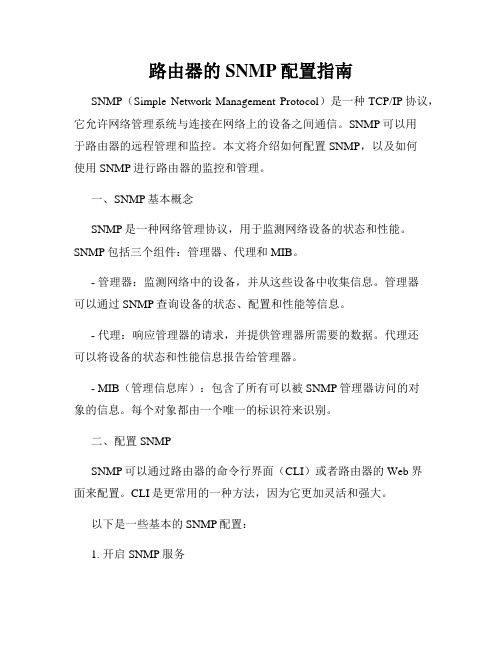
路由器的SNMP配置指南SNMP(Simple Network Management Protocol)是一种TCP/IP协议,它允许网络管理系统与连接在网络上的设备之间通信。
SNMP可以用于路由器的远程管理和监控。
本文将介绍如何配置SNMP,以及如何使用SNMP进行路由器的监控和管理。
一、SNMP基本概念SNMP是一种网络管理协议,用于监测网络设备的状态和性能。
SNMP包括三个组件:管理器、代理和MIB。
- 管理器:监测网络中的设备,并从这些设备中收集信息。
管理器可以通过SNMP查询设备的状态、配置和性能等信息。
- 代理:响应管理器的请求,并提供管理器所需要的数据。
代理还可以将设备的状态和性能信息报告给管理器。
- MIB(管理信息库):包含了所有可以被SNMP管理器访问的对象的信息。
每个对象都由一个唯一的标识符来识别。
二、配置SNMPSNMP可以通过路由器的命令行界面(CLI)或者路由器的Web界面来配置。
CLI是更常用的一种方法,因为它更加灵活和强大。
以下是一些基本的SNMP配置:1. 开启SNMP服务首先,需要在路由器上开启SNMP服务。
使用下面的命令来开启SNMP服务:Router(config)#snmp-server engineID remote 1.3.6.1.4.1.8072.99992. 配置团体名团体名是SNMP中的一个重要概念,它用于标识允许访问SNMP的设备。
使用下面的命令来配置团体名:Router(config)#snmp-server community public RO在上面的命令中,public是团体名,RO表示只读权限。
如果需要设置读写权限,则使用如下命令:Router(config)#snmp-server community private RW在上面的命令中,private是团体名,RW表示读写权限。
3. 配置SNMP目标SNMP目标是SNMP代理,它用于接收SNMP请求并返回SNMP 响应。
华三SNMP配置详解
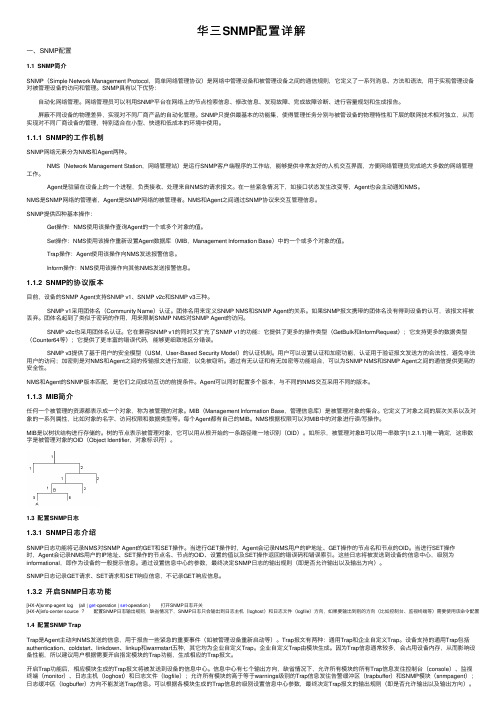
华三SNMP配置详解⼀、SNMP配置1.1 SNMP简介SNMP(Simple Network Management Protocol,简单⽹络管理协议)是⽹络中管理设备和被管理设备之间的通信规则,它定义了⼀系列消息、⽅法和语法,⽤于实现管理设备对被管理设备的访问和管理。
SNMP具有以下优势: ⾃动化⽹络管理。
⽹络管理员可以利⽤SNMP平台在⽹络上的节点检索信息、修改信息、发现故障、完成故障诊断、进⾏容量规划和⽣成报告。
屏蔽不同设备的物理差异,实现对不同⼚商产品的⾃动化管理。
SNMP只提供最基本的功能集,使得管理任务分别与被管设备的物理特性和下层的联⽹技术相对独⽴,从⽽实现对不同⼚商设备的管理,特别适合在⼩型、快速和低成本的环境中使⽤。
1.1.1 SNMP的⼯作机制SNMP⽹络元素分为NMS和Agent两种。
NMS(Network Management Station,⽹络管理站)是运⾏SNMP客户端程序的⼯作站,能够提供⾮常友好的⼈机交互界⾯,⽅便⽹络管理员完成绝⼤多数的⽹络管理⼯作。
Agent是驻留在设备上的⼀个进程,负责接收、处理来⾃NMS的请求报⽂。
在⼀些紧急情况下,如接⼝状态发⽣改变等,Agent也会主动通知NMS。
NMS是SNMP⽹络的管理者,Agent是SNMP⽹络的被管理者。
NMS和Agent之间通过SNMP协议来交互管理信息。
SNMP提供四种基本操作:Get操作:NMS使⽤该操作查询Agent的⼀个或多个对象的值。
Set操作:NMS使⽤该操作重新设置Agent数据库(MIB,Management Information Base)中的⼀个或多个对象的值。
Trap操作:Agent使⽤该操作向NMS发送报警信息。
Inform操作:NMS使⽤该操作向其他NMS发送报警信息。
1.1.2 SNMP的协议版本⽬前,设备的SNMP Agent⽀持SNMP v1、SNMP v2c和SNMP v3三种。
SNMP的配置开启及H3C设备如何配置SNMP协议
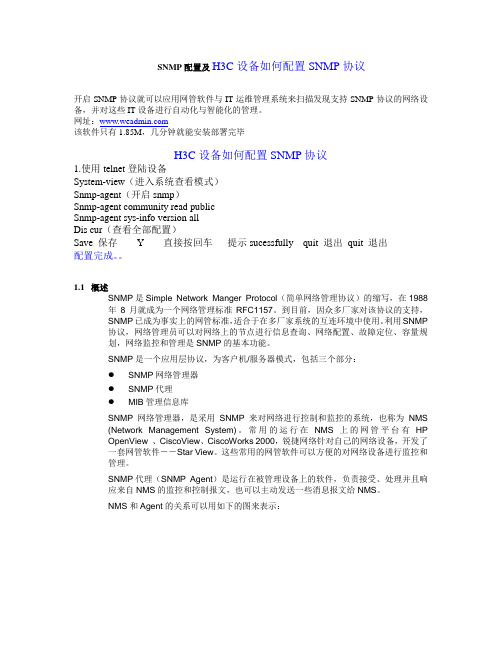
SNMP配置及H3C设备如何配置SNMP协议开启SNMP协议就可以应用网管软件与IT运维管理系统来扫描发现支持SNMP协议的网络设备,并对这些IT设备进行自动化与智能化的管理。
网址:该软件只有1.85M,几分钟就能安装部署完毕H3C设备如何配置SNMP协议1.使用telnet登陆设备System-view(进入系统查看模式)Snmp-agent(开启snmp)Snmp-agent community read publicSnmp-agent sys-info version allDis cur(查看全部配置)Save 保存Y 直接按回车提示sucessfully quit 退出quit 退出配置完成。
1.1 概述SNMP是Simple Network Manger Protocol(简单网络管理协议)的缩写,在1988年8月就成为一个网络管理标准RFC1157。
到目前,因众多厂家对该协议的支持,SNMP已成为事实上的网管标准,适合于在多厂家系统的互连环境中使用。
利用SNMP协议,网络管理员可以对网络上的节点进行信息查询、网络配置、故障定位、容量规划,网络监控和管理是SNMP的基本功能。
SNMP是一个应用层协议,为客户机/服务器模式,包括三个部分:●SNMP网络管理器●SNMP代理●MIB管理信息库SNMP网络管理器,是采用SNMP来对网络进行控制和监控的系统,也称为NMS (Network Management System)。
常用的运行在NMS上的网管平台有HP OpenView 、CiscoView、CiscoWorks 2000,锐捷网络针对自己的网络设备,开发了一套网管软件--Star View。
这些常用的网管软件可以方便的对网络设备进行监控和管理。
SNMP代理(SNMP Agent)是运行在被管理设备上的软件,负责接受、处理并且响应来自NMS的监控和控制报文,也可以主动发送一些消息报文给NMS。
华为交换机 01-01 SNMP配置
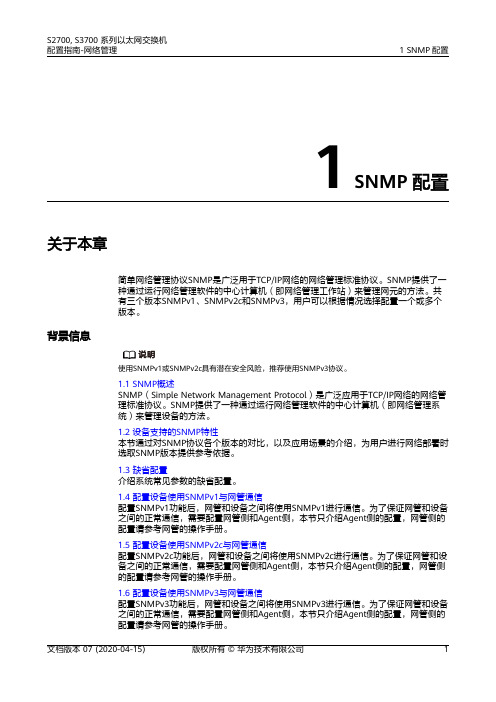
1.3 缺省配置 介绍系统常见参数的缺省配置。
1.4 配置设备使用SNMPv1与网管通信 配置SNMPv1功能后,网管和设备之间将使用SNMPv1进行通信。为了保证网管和设备 之间的正常通信,需要配置网管侧和Agent侧,本节只介绍Agent侧的配置,网管侧的 配置请参考网管的操作手册。
版权所有 © 华为技术有限公司
3
S2700, S3700 系列以太网交换机 配置指南-网络管理
1 SNMP 配置
表 1-3 SNMP 各版本的应用场景
版本
应用场景
SNMPv1 适用于小型网络,组网简单,对网络安全性要求不高或者网络环境本身 比较安全,且比较稳定的网络,比如校园网,小型企业网。
SNMPv2 c
错误码
错误码用来标识特定的故障现象,有助于管理员快速定位和解决故障, 因此错误码越丰富越有利于管理员对设备进行管理。
文档版本 07 (2020-04-15)
版权所有 © 华为技术有限公司
2
S2700, S3700 系列以太网交换机 配置指南-网络管理
1 SNMP 配置
特性
功能描述
Trap告警
Trap告警是被管理设备主动向网管发送告警。以便管理员能够及时发现 设备的异常。
说明
NMS上配置的团体名需和Agent上配置的团体名保持一致,否则NMS将无法访问Agent。
步骤5 执行命令snmp-agent target-host trap address udp-domain ip-address [ udpport port-number ] [ source interface-type interface-number ] [ public-net | vpninstance vpn-instance-name ] params securityname { security-name | cipher security-name } [ v1 ] [ ext-vb ],配置设备发送告警和错误码的目的IP地址。
snmp对接参数
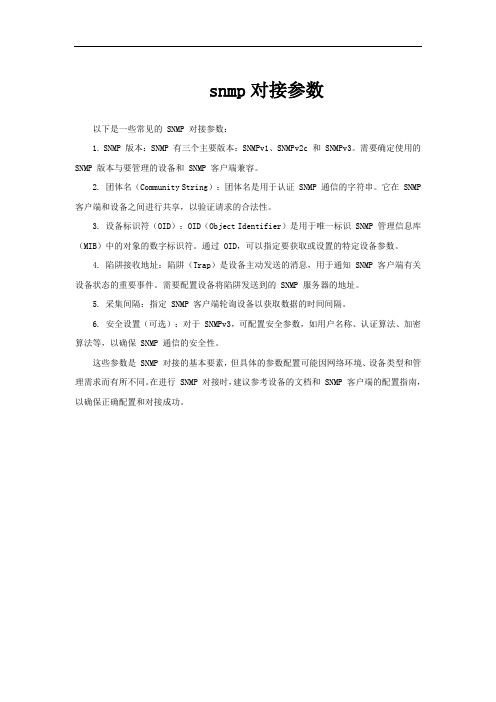
snmp对接参数
以下是一些常见的 SNMP 对接参数:
1. SNMP 版本:SNMP 有三个主要版本:SNMPv1、SNMPv2c 和 SNMPv3。
需要确定使用的SNMP 版本与要管理的设备和 SNMP 客户端兼容。
2. 团体名(Community String):团体名是用于认证 SNMP 通信的字符串。
它在 SNMP 客户端和设备之间进行共享,以验证请求的合法性。
3. 设备标识符(OID):OID(Object Identifier)是用于唯一标识 SNMP 管理信息库(MIB)中的对象的数字标识符。
通过 OID,可以指定要获取或设置的特定设备参数。
4. 陷阱接收地址:陷阱(Trap)是设备主动发送的消息,用于通知 SNMP 客户端有关设备状态的重要事件。
需要配置设备将陷阱发送到的 SNMP 服务器的地址。
5. 采集间隔:指定 SNMP 客户端轮询设备以获取数据的时间间隔。
6. 安全设置(可选):对于 SNMPv3,可配置安全参数,如用户名称、认证算法、加密算法等,以确保 SNMP 通信的安全性。
这些参数是 SNMP 对接的基本要素,但具体的参数配置可能因网络环境、设备类型和管理需求而有所不同。
在进行 SNMP 对接时,建议参考设备的文档和 SNMP 客户端的配置指南,以确保正确配置和对接成功。
SNMP 信息配置

SNMP 信息配置配置向导温州索思信息工程有限公司工程部2010年7月修订文档历史记录定稿日期版本说明文档参与人文档整理人文档审核人2010年7月11日V1.0 初始版本陈坚陈坚目录一:SNMP 简介简单网络管理协议(SNMP)简单网络管理协议(SNMP)是最早提出的网络管理协议之一,它一推出就得到了广泛的应用和支持,特别是很快得到了数百家厂商的支持,其中包括IBM,HP,SUN等大公司和厂商。
目前SNMP已成为网络管理领域中事实上的工业标准,并被广泛支持和应用,大多数网络管理系统和平台都是基于SNMP的。
一、SNMP概述SNMP的前身是简单网关监控协议(SGMP),用来对通信线路进行管理。
随后,人们对SGMP进行了很大的修改,特别是加入了符合Internet定义的SMI和MIB:体系结构,改进后的协议就是著名的SNMP。
SNMP的目标是管理互联网Internet 上众多厂家生产的软硬件平台,因此SNMP受Internet标准网络管理框架的影响也很大。
现在SNMP已经出到第三个版本的协议,其功能较以前已经大大地加强和改进了。
SNMP的体系结构是围绕着以下四个概念和目标进行设计的:保持管理代理(agent)的软件成本尽可能低;最大限度地保持远程管理的功能,以便充分利用Internet的网络资源;体系结构必须有扩充的余地;保持SNMP的独立性,不依赖于具体的计算机、网关和网络传输协议。
在最近的改进中,又加入了保证SNMP 体系本身安全性的目标。
另外,SNMP中提供了四类管理操作:get操作用来提取特定的网络管理信息;get-next操作通过遍历活动来提供强大的管理信息提取能力;set操作用来对管理信息进行控制(修改、设置);trap操作用来报告重要的事件。
二:SNMP的配置2.1 linux 配置 SNMP信息:1、确保本机已经安装了snmp服务[root@idc ~]# rpm -qa |grep snmpnet-snmp-libs-5.1.2-11.EL4.7 --nodeps --forcenet-snmp-5.1.2-11.EL4.7如果没有,那么放入linux安装盘找到snmp的rpm包进行安装,或者到网上搜索适合自己linux发行版本的rpm包进行安装在新版本的centos及redhat es版本中可能在安装时会提示依赖性错误,这时需要安装lm_sensors-2.8.7-2.40.3.i386.rpm,再安装netsnmp软件。
常见网络设备SNMP配置指南
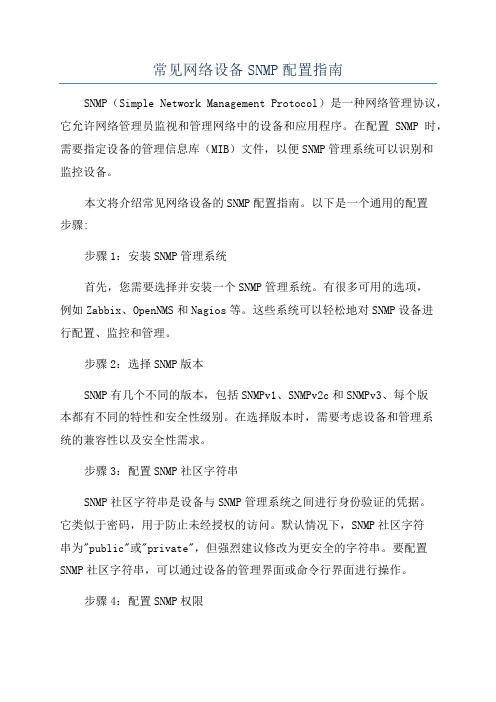
常见网络设备SNMP配置指南SNMP(Simple Network Management Protocol)是一种网络管理协议,它允许网络管理员监视和管理网络中的设备和应用程序。
在配置SNMP时,需要指定设备的管理信息库(MIB)文件,以便SNMP管理系统可以识别和监控设备。
本文将介绍常见网络设备的SNMP配置指南。
以下是一个通用的配置步骤:步骤1:安装SNMP管理系统首先,您需要选择并安装一个SNMP管理系统。
有很多可用的选项,例如Zabbix、OpenNMS和Nagios等。
这些系统可以轻松地对SNMP设备进行配置、监控和管理。
步骤2:选择SNMP版本SNMP有几个不同的版本,包括SNMPv1、SNMPv2c和SNMPv3、每个版本都有不同的特性和安全性级别。
在选择版本时,需要考虑设备和管理系统的兼容性以及安全性需求。
步骤3:配置SNMP社区字符串SNMP社区字符串是设备与SNMP管理系统之间进行身份验证的凭据。
它类似于密码,用于防止未经授权的访问。
默认情况下,SNMP社区字符串为"public"或"private",但强烈建议修改为更安全的字符串。
要配置SNMP社区字符串,可以通过设备的管理界面或命令行界面进行操作。
步骤4:配置SNMP权限SNMP有几个级别的权限,包括只读和读写。
只读权限允许管理系统获取设备的信息,而读写权限则允许管理系统修改设备的设置。
您可以根据要求设置适当的权限级别。
步骤5:配置SNMP陷阱SNMP陷阱是设备在特定事件发生时发送给管理系统的通知。
您可以配置陷阱来监控设备的状态并及时采取行动。
要配置SNMP陷阱,您需要指定陷阱的目的地(即管理系统的IP地址)以及触发陷阱的条件。
步骤6:测试SNMP设置在完成SNMP配置后,最好进行测试以确保一切正常。
您可以使用SNMP管理系统来获取设备的状态和信息,确保它与实际情况一致。
除了以上通用的配置步骤外,不同的网络设备可能还有一些特定的配置要求。
SNMP网络管理协议的配置与使用

SNMP网络管理协议的配置与使用SNMP(Simple Network Management Protocol)是网络管理协议中广泛使用的一种协议,它可以用来监控网络设备的状态、收集性能数据等。
本文将介绍SNMP协议的基本原理、配置和使用。
SNMP协议的基本原理SNMP协议是基于客户端/服务器模型的协议,主要由三个组成部分组成:管理站、代理和网络设备。
其中,管理站是一个用来管理网络设备的计算机,代理则是安装在网络设备上的软件,它们可以帮助管理站收集和汇总设备的状态和性能数据。
网络设备则是指需要被管理的网络设备,如交换机、路由器等。
在SNMP协议中,管理站将会发出一些命令,代理则可以根据这些命令来获取设备的状态和性能数据,并将其返回给管理站。
这些命令主要包括GET(获取指定的对象)、SET(设置指定的对象)、GETNEXT(获取下一个对象)和GETBULK(获取一组对象)等。
SNMP协议的配置在SNMP协议中,需要完成两个配置:管理站的配置和网络设备的配置。
管理站的配置管理站通常会安装一些SNMP客户端软件,用于连接代理并获取设备的状态和性能数据。
在配置管理站时,需要指定下列信息:1.代理的IP地址和端口号2.团体名或密码团体名或密码是SNMP协议用来进行身份验证和访问控制的重要参数。
在SNMP中,可以有多个团体名,每个团体名都对应了不同的安全级别。
例如,public团体名表示最低安全级别,它允许管理站只读地查看设备上的某些对象,而private则表示一种更高的安全级别,它允许管理站对设备上的某些对象进行读写操作。
网络设备的配置网络设备上也需要安装SNMP代理程序,并进行相应的配置。
在配置网络设备时,需要指定下列信息:1.代理的IP地址和端口号2.团体名或密码3.管理站允许访问的对象列表管理站通常只需要访问设备的一些对象,如设备的CPU利用率、内存使用率等,而不需要访问全部对象。
因此,网络设备需要配置一个允许管理站访问的对象列表,以免管理站访问过多的对象,导致设备性能下降。
华为SNMP配置

简板1. 首先,要设置使用的SNMP的版本[Quidway]snmp-agent sys-info v ersion ?all 使设备支持版本SNMPv1,SNMPv2c和SNMPv3v1 支持SNMPv1v2c 支持SNMPv2cv3 支持SNMPv3[Quidway]snmp-agent sys-info v ersion v1 v2c2. 对于v1 v2c来说,只需要设定团体字即可[Quidway]snmp-agent community ?read 该团体名在指定视图内有只读权限write 该团体名在指定视图内有读写权限[Quidway]snmp-agent community read public[Quidway]snmp-agent community write private[Quidway]snmp-agent trap ?SNMP陷阱/通知使能命令组enable设置trap老化时间lifequeue-size 每个TRAP消息队列长度设置Trap报文源地址source[Quidway]snmp-agent trap enable[Quidway]snmp-agent target-host ?trap 指定该主机为trap主机[Quidway]snmp-agent target-host trap ?address 指定用于SNMP消息产生的传输地址[Quidway]snmp-agent target-host trap address udp-domain 192.168.1.1 ud p-port 5000 ?params 指定用于SNMP消息产生的SNMP目标主机信息[Quidway]snmp-agent target-host trap address udp-domain 192.168.1.1 ud p-port 5000 params ?securityname 指定代表生成SNMP消息的主体名[Quidway]snmp-agent target-host trap address udp-domain 192.168.1.1 ud p-port 5000 paramssecurityname ?STRING<1-32> 指定安全名字符串[Quidway]snmp-agent target-host trap address udp-domain 192.168.1.1 ud p-port 5000 paramssecurityname public[Quidway]4. 对于V3,需要的是MIB视图和读写的组snmp v3设置:[Quidway]snmp-agent ?为SNMPv1&SNMPv2c访问设置团体名community设置基于用户安全模型的组group设置本地SNMP实体的引擎IDlocal-engineidmib-view创建或者更新SNMP MIB视图的信息设置SNMP报文参数packet设置该设备节点的系统信息sys-info设置接收SNMP通知/陷阱报文的目标主机target-host设置SNMP 陷阱/通知相关参数trap设置SNMP实体访问用户usm-user<cr>[Quidway]snmp-agent sys-info v ersion ?all 使设备支持版本SNMPv1,SNMPv2c和SNMPv3v1 支持SNMPv1v2c 支持SNMPv2cv3 支持SNMPv3[Quidway]snmp-agent sys-info v ersion v3[Quidway]snmp-agent mib-view ?excluded 排除MIB子树included 包括MIB子树[Quidway]snmp-agent mib-view included ?STRING<1-32> 视图名字符串[Quidway]snmp-agent mib-view included wnmview ?STRING<1-255> MIB对象子树名称[Quidway]snmp-agent mib-view included wnmview internet[Quidway]snmp-agent group v3 wnmgroup ?为该组指定访问控制列表aclauthentication指明该组名具有认证不加密的安全级别指定该组名对应的通知视图notify-viewprivacy指明该组名具有认证和加密的安全级别设置该组名对应的只读视图read-view指定该组名对应的读写视图write-view<cr>[Quidway]snmp-agent group v3 wnmgroup privacy ?为该组指定访问控制列表aclnotify-view 指定该组名对应的通知视图read-view 设置该组名对应的只读视图指定该组名对应的读写视图write-view<cr>[Quidway]snmp-agent group v3 wnmgroup privacy r ead-view wnmview wr ite-view wnmview notify-view wnmview[Quidway]snmp-agent ?为SNMPv1&SNMPv2c访问设置团体名communitygroup设置基于用户安全模型的组设置本地SNMP实体的引擎IDlocal-engineid创建或者更新SNMP MIB视图的信息mib-view设置SNMP报文参数packet设置该设备节点的系统信息sys-info设置接收SNMP通知/陷阱报文的目标主机target-host设置SNMP 陷阱/通知相关参数trap设置SNMP实体访问用户usm-user<cr>[Quidway]snmp-agent usm-user ?v1 利用SNMPv1安全模型的用户v2c 利用SNMPv2c安全模型的用户v3 利用USM(SNMPv3)安全模型的用户[Quidway]snmp-agent usm-user v3 ?STRING<1-32> 用户名字符串[Quidway]snmp-agent usm-user v3 wnm ?STRING<1-32> 指定用户所属的组名字符串[Quidway]snmp-agent usm-user v3 wnm wnmview ?acl为该用户设定访问控制列表authentication-mode 指定用户鉴别模式<cr>[Quidway]snmp-agent usm-user v3 wnm wnmgroup authentication-mode ? md5 使用HMAC MD5算法进行鉴别sha 使用HMAC SHA算法进行鉴别[Quidway]snmp-agent usm-user v3 wnm wnmgroup authentication-mode md5 1234567[Quidway]snmp-agent trap enable standard[Quidway]snmp-agent target-host trap address udp-domain 192.168.1.1 ud p-port 5000 paramssecurityname wnm v3[Quidway]华为手册:第5章/ SNMP配置5.1 SNMP协议介绍目前网络中用得最广泛的网络管理协议是SNMP(Simple NetworkManagement Protocol)。
H3C配置SNMP协议
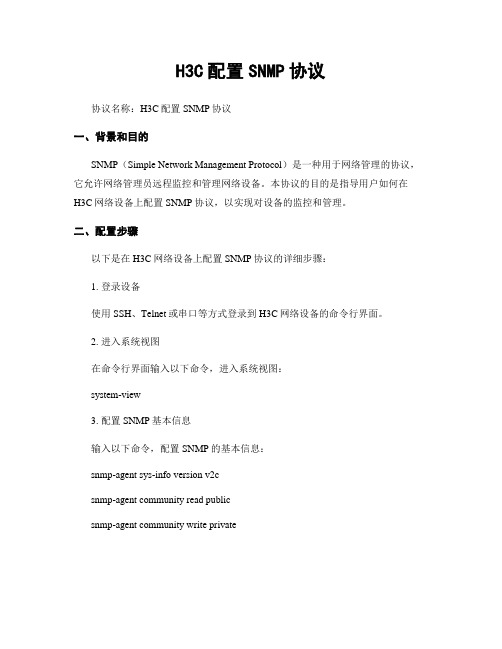
H3C配置SNMP协议协议名称:H3C配置SNMP协议一、背景和目的SNMP(Simple Network Management Protocol)是一种用于网络管理的协议,它允许网络管理员远程监控和管理网络设备。
本协议的目的是指导用户如何在H3C网络设备上配置SNMP协议,以实现对设备的监控和管理。
二、配置步骤以下是在H3C网络设备上配置SNMP协议的详细步骤:1. 登录设备使用SSH、Telnet或串口等方式登录到H3C网络设备的命令行界面。
2. 进入系统视图在命令行界面输入以下命令,进入系统视图:system-view3. 配置SNMP基本信息输入以下命令,配置SNMP的基本信息:snmp-agent sys-info version v2csnmp-agent community read publicsnmp-agent community write private其中,sys-info version v2c表示使用SNMP版本为v2c,community read public表示设置读取共同体为public,community write private表示设置写入共同体为private。
您可以根据需要修改这些参数。
4. 配置SNMP TrapSNMP Trap用于向管理系统发送警报和通知。
输入以下命令,配置SNMP Trap:snmp-agent trap enablesnmp-agent target-host trap-addr udp-domain 192.168.0.1 params securityname public其中,192.168.0.1是管理系统的IP地址,securityname public表示使用public作为安全名称。
您需要根据实际情况修改这些参数。
5. 配置SNMP视图SNMP视图用于限制SNMP管理者的访问权限。
输入以下命令,配置SNMP视图:snmp-agent view v1 default includedsnmp-agent view v2c default includedsnmp-agent view v3 default included6. 配置SNMP用户输入以下命令,配置SNMP用户:snmp-agent usm-user v3 user-name adminsnmp-agent usm-user v3 user-name admin authentication-mode shasnmp-agent usm-user v3 user-name admin privacy-mode aes128snmp-agent usm-user v3 user-name admin security-level authPrivsnmp-agent usm-user v3 user-name admin authentication-mode shasnmp-agent usm-user v3 user-name admin privacy-mode aes128snmp-agent usm-user v3 user-name admin security-level authPriv其中,user-name admin表示用户名为admin,authentication-mode sha表示使用SHA算法进行身份验证,privacy-mode aes128表示使用AES-128算法进行数据加密,security-level authPriv表示安全级别为authPriv。
SNMP配置指南
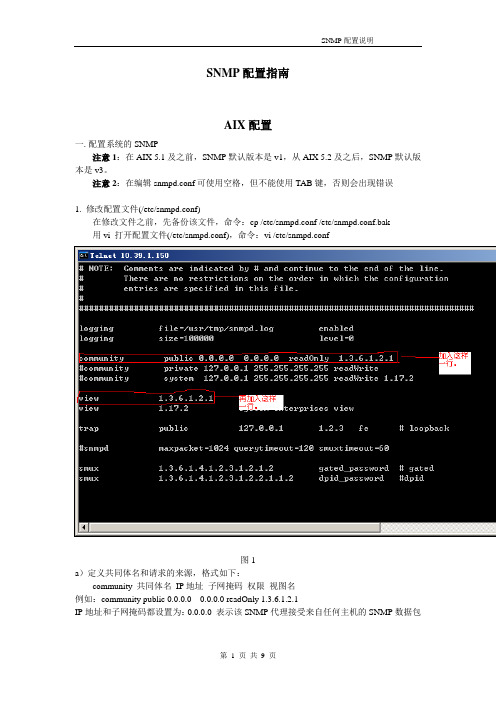
SNMP配置指南AIX配置一.配置系统的SNMP注意1:在AIX 5.1及之前,SNMP默认版本是v1,从AIX 5.2及之后,SNMP默认版本是v3。
注意2:在编辑snmpd.conf可使用空格,但不能使用TAB键,否则会出现错误1. 修改配置文件(/etc/snmpd.conf)在修改文件之前,先备份该文件,命令:cp /etc/snmpd.conf /etc/snmpd.conf.bak用vi 打开配置文件(/etc/snmpd.conf),命令:vi /etc/snmpd.conf图1a)定义共同体名和请求的来源,格式如下:community 共同体名IP地址子网掩码权限视图名例如:community public 0.0.0.0 0.0.0.0 readOnly 1.3.6.1.2.1IP地址和子网掩码都设置为:0.0.0.0 表示该SNMP代理接受来自任何主机的SNMP数据包找到community public,将该行删除,新加入一行:community public 0.0.0.0 0.0.0.0 readOnly 1.3.6.1.2.1如果没有community public,就在logging size=100000 level=0 下面加入一行:community public 0.0.0.0 0.0.0.0 readOnly 1.3.6.1.2.1b)定义视图,格式如下:view 视图名例如:view 1.3.6.1.2.1找到view 1.17.2 system enterprises view,在该行上面加入一行:view 1.3.6.1.2.1配置文件(/etc/snmpd.conf)修改完成,如图1所示。
2. 查看当前SNMP的版本输入ls -l /usr/sbin/snmpd输出lrwxrwxrwx 1 root system 19 Jan 08 11:11 /usr/sbin/snmpd -> /usr/sbin/snmpdv3ne上面红色部分说明SNMP的版本是v3,需要将SNMP的版本修改为v1。
- 1、下载文档前请自行甄别文档内容的完整性,平台不提供额外的编辑、内容补充、找答案等附加服务。
- 2、"仅部分预览"的文档,不可在线预览部分如存在完整性等问题,可反馈申请退款(可完整预览的文档不适用该条件!)。
- 3、如文档侵犯您的权益,请联系客服反馈,我们会尽快为您处理(人工客服工作时间:9:00-18:30)。
一、在思科的路由器上配置SNMP(启用SNMP代理)、开启SNMP服务5、案例:配置网管工作站接收被管设备的陷阱消息(1)启用陷阱消息接收器----打开162端口(2)配置团体名(3)在snmp代理上配置陷阱消息snmp-server host 192.168.4.231 sdxh #配置陷阱消息的目标snmp-server enable traps config #配置启用trap 配置事件(注:只是其中的一种消息类型,可以配置多个)(4)效果二、在思科交换机上配置SNMP1、配置管理地址三、在思科ASA上启用SNMP1、防火墙只支持只读SNMP2、SNMPv3支持更强的认证:用户名、认证密钥、加密密钥四、在Windows Server上启用SNMP在Linux中启用SNMP五、五、在1、yum仓库的配置(以本地光盘为yum安装源)mount /dev/cdrom /media/cdrom/rpm --import /etc/pki/rpm-gpg/RPM-GPG-KEY-redhat-release 导入签名密钥1)、vi /etc/yum.repos.d/rhel6.repo[rhel-source] #仓库的名称name=Red Hat Enterprise Linux $releasever - $basearch - Source #描述baseurl=file:///media/cdrom #位置enabled=1 #启用仓库gpgcheck=1 #启用签名检查gpgkey=file:///etc/pki/rpm-gpg/RPM-GPG-KEY-redhat-release #签名密钥3)、相关软件包将snmp服务设为开机自动启动:修改允许查看的MIB库信息87 view all included .1 8091 view mib2 included .dod.internet.mgmt.mib-2 fc 设置团体名的权限(在文件的结尾)snmpwalk -v 2c 192.168.4.213 -c sdxh systemsnmpwalk -v 2c 192.168.4.254 -c sdxh ifDescr.1snmpnetstat -v 2c -c sdxh -Ca -Cp tcp 192.168.4.213 #查看tcp连接启用SNMP-V3:3、【补充】Setting Up SNMPThis HowTo will explain how to install and configure the Net-SNMP agent. At time of writing, the latest version available is 5.4 (published on 12/06/2006).Getting Net-SNMP binariesDepending on your operating system, you'll find packages or tarballs to install Net-SNMP :LinuxUsually every Linux distribution comes with Net-SNMP packages :RedHat / Fedora : install the net-snmp, net-snmp-libs and net-snmp-utils packagesDebian / Ubuntu: install the libsnmp-base, libsnmp5, snmp and snmpd packagesSuSE : install the net-snmp packageGentoo : simply emerge the net-snmp ebuildMandriva : install the libnet-snmp5, net-snmp and net-snmp-utils packages.agentaddress 10.20.30.40:10000You can also make it listens on TCP, which is supported by Cactiagentaddress tcp:161The “tcp” keyword can then be used in Cacti :For those who want some more security, you can use the SNMP version 3 protocol, with MD5 or SHA hashing:createUser frederic MD5 mypassphrase DESgroup groupv3 usm fredericview all included .iso 80access groupv3 "" any auth exact all all allThis creates a user “frederic” whose password is “mypassphrase”. To test it:# snmpget -v 3 -l AuthNoPriv -u frederic -A mypassphrase 10.50.80.45 sysName.0SNMPv2-MIB::sysName.0 = STRING: cyclopesIn Cacti, add your device, choose SNMP version 3, and fill the username and password fields:Now that you're done with access control, add these 2 lines in snmpd.conf to indicate the location and contact name of your device:syslocation Bat. C2syscontact someone@They will then appear in Cacti management interface :Some OIDs return a unit, eg ”-153.1 dBm”.It's a safe idea to turn this off, by adding this to snmpd.conf:dontPrintUnits trueNext step is to graph filesystems in Cacti; the easyest way is to add this line in snmpd.conf:includeAllDisksWhen you'll run the “ucd/net - Get Monitored Partitions” Data Query, all the mounted filesystems will show up:If you want a filesystem not to be listed here, add this line to snmpd.conf:ignoredisk /dev/rdsk/c0t2d0Unfortunatly, some older versions of Net-SNMP do not fully work with the includeAllDisks keywordYou'll then have to list explicitly all filesystems you want to graph:disk /disk /usrdisk /vardisk /oracleYou can also specify NFS mount points.Please note that the Net-SNMP agent can only report filesystems which where mounted before its start.If you manually mount filesystems later, you'll have to reload the Net-SNMP agent (send the HUP signal).You can also graph processes, by adding this to snmpd.conf:proc httpdThe result will be accessible under the ucdavis.prTable.prEntry tree:prCount, number of current processes running with the name in questionprNames, the process name you're counting.In our example, the number of Apache processes will be available under the .1.3.6.1.4.1.2021.2.1.5 OID Some useful mib modules are:mibII/mta_sendmail, to graph MTA (Sendmail, Postfix, etc.) statisticsdiskio, to enable to graph I/O statisticsucd-snmp/lmSensors, for hardware monitoring (Linux and Solaris only)Mib modules can be added like this:$ ./configure --with-mib-modules="module1 module2"To compile Net-SNMP and build a compressed archive, follow these steps:$ ./configure --with-your-options$ make# mkdir /usr/local/dist# make install prefix=/usr/local/dist/usr/local exec_prefix=/usr/local/dist/usr/local# cd /usr/local/dist# tar cvf /tmp/net-snmp-5.3.1-dist.tar usr# gzip /tmp/net-snmp-5.3.1-dist.tar# rm -rf /usr/local/distYou can then copy the /tmp/net-snmp-5.3.1-dist.tar.gz file to other servers, and uncompress it from the root directory (everything will get extracted to /usr/local).Test your configurationOnce Net-SNMP is configured and started, here's how to test it:$ snmpwalk -v 1 -c public localhost .1.3.6.1.2.1.1.1.0SNMPv2-MIB::sysDescr.0 = STRING: Linux cronos 2.4.28 #2 SMP ven jan 14 14:12:01 CET 2005 i686This basic query shows that your Net-SNMP agent is reachable.You can even query which Net-SNMP version is running on a host:$ snmpwalk -v 1 -c public localhost .1.3.6.1.4.1.2021.100.2.0UCD-SNMP-MIB::versionTag.0 = STRING: 5.2.1.2An answer like that one$ snmpwalk -v 1 -c foo localhost .1.3.6.1.2.1.1.1.0Timeout: No Response from localhostindicates that either the agent is not started, or that the community string is incorrect, or that this device is unreachable. Check your community string, add firewall rules if necessary, etc.If using SNMP version 3, specifying an unknown user will result in this error message :$ snmpget -v 3 -l AuthNoPriv -u john -A mypassphrase 10.50.80.45 sysName.0snmpget: Unknown user nameAn incorrect passphrase will result in this error message :$ snmpget -v 3 -l AuthNoPriv -u frederic -A badpassphrase 10.50.80.45 sysName.0snmpget: Authentication failure (incorrect password, community or key)This query will show you what filesystems are mounted:$ snmpwalk -v 1 -c public localhost .1.3.6.1.4.1.2021.9.1.2UCD-SNMP-MIB::dskPath.1 = STRING: /UCD-SNMP-MIB::dskPath.2 = STRING: /BBUCD-SNMP-MIB::dskPath.3 = STRING: /dev/shmIf the answer is empty, usually it means the includeAllDisks is not supported by your Net-SNMP agent (you'll have to list each filesystem you want to graph as explained in previous chapter).Finally, this query will you display your network interfaces:$ snmpwalk -v 1 -c public localhost .1.3.6.1.2.1.2.2.1.2IF-MIB::ifDescr.1 = STRING: loIF-MIB::ifDescr.2 = STRING: eth0IF-MIB::ifDescr.3 = STRING: eth1Extending the SNMP AgentA great functionnality of Net-SNMP is that you can “extend” it.Let's run the /tmp/foo.sh script:$ /tmp/foo.sh -arg1123Now put this in snmpd.conf:exec foo /bin/sh /tmp/foo.sh -arg1The result of your script will be accessible under the ucdavis.extTable.extEntry tree: * output of the script :ucdavis.extTable.extEntry.extOutput * exit status: ucdavis.extTable.extEntry.extResult * command:ucdavis.extTable.extEntry.extCommandYou can check the result with this SNMP query:$ snmpwalk -v 1 -c public localhost .1.3.6.1.4.1.2021.8.1UCD-SNMP-MIB::extIndex.1 = INTEGER: 1UCD-SNMP-MIB::extNames.1 = STRING: fooUCD-SNMP-MIB::extCommand.1 = STRING: /bin/sh /tmp/foo.sh -arg1UCD-SNMP-MIB::extResult.1 = INTEGER: 0UCD-SNMP-MIB::extOutput.1 = STRING: 123UCD-SNMP-MIB::extErrFix.1 = INTEGER: 0UCD-SNMP-MIB::extErrFixCmd.1 = STRING:extOutput translates to .1.3.6.1.4.1.2021.8.1.101 As “foo” is our first exec directive, add .1 at the end of the OID.In Cacti, use the “SNMP - Generic OID Template” like this:Voila! Result of the /tmp/foo.sh script is now graphed in Cacti.Now let's run this second script, which returns more than one result:$ /tmp/bar.sh456789It returns two values, one per line (this is important).Another way to call scripts from snmpd.conf is by specifying an OID, like this:exec .1.3.6.1.4.1.2021.555 /bin/sh /tmp/bar.shRun this query:$ snmpwalk -v 1 -c public localhost .1.3.6.1.4.1.2021.555UCD-SNMP-MIB::ucdavis.555.1.1 = INTEGER: 1UCD-SNMP-MIB::ucdavis.555.2.1 = STRING: "/bin/sh"UCD-SNMP-MIB::ucdavis.555.3.1 = STRING: "/tmp/bar.sh"UCD-SNMP-MIB::ucdavis.555.100.1 = INTEGER: 0UCD-SNMP-MIB::ucdavis.555.101.1 = STRING: "456"UCD-SNMP-MIB::ucdavis.555.101.2 = STRING: "789"UCD-SNMP-MIB::ucdavis.555.102.1 = INTEGER: 0UCD-SNMP-MIB::ucdavis.555.103.1 = ""First line returned by the script will be available at .1.3.6.1.4.1.2021.555.101.1, second one at .1.3.6.1.4.1.2021.555.101.2, and so on.You can then use the “SNMP - Generic OID Template” in Cacti (one Data Source per OID).Let's say you want to count the number of entries in a log file. Add this to snmpd.conf:logmatch cactistats /home/cactiuser/cacti/log/cacti.log 120 SYSTEM STATS* the global count of matches will be available under the .1.3.6.1.4.1.2021.16.2.1.5.1 OID * the “Regex match counter” (which is reset with each file rotation) will be available under the .1.3.6.1.4.1.2021.16.2.1.7.1 OIDTo list all the available variables, use this query:$ snmpwalk -v 1 -c public localhost logMatchUCD-SNMP-MIB::logMatchMaxEntries.0 = INTEGER: 50UCD-SNMP-MIB::logMatchIndex.1 = INTEGER: 1UCD-SNMP-MIB::logMatchName.1 = STRING: cactistatsUCD-SNMP-MIB::logMatchFilename.1 = STRING: /home/cactiuser/cacti/log/cacti.logUCD-SNMP-MIB::logMatchRegEx.1 = STRING: SYSTEM STATSUCD-SNMP-MIB::logMatchGlobalCounter.1 = Counter32: 301634UCD-SNMP-MIB::logMatchGlobalCount.1 = INTEGER: 301634UCD-SNMP-MIB::logMatchCurrentCounter.1 = Counter32: 6692UCD-SNMP-MIB::logMatchCurrentCount.1 = INTEGER: 6692https:///autho/forms/CDClogin.html# 获取端口Index[root@redhat mibs]# snmpwalk -v 2c 192.168.4.254 -c sdxh 1.3.6.1.2.1.2.2.1.1 IF-MIB::ifIndex.1 = INTEGER: 1IF-MIB::ifIndex.2 = INTEGER: 2IF-MIB::ifIndex.3 = INTEGER: 3# 获取端口列表及其描述[root@redhat mibs]# snmpwalk -v 2c 192.168.4.254 -c sdxh 1.3.6.1.2.1.2.2.1.2 IF-MIB::ifDescr.1 = STRING: FastEthernet0/0# 以下为获取交换机第2个端口(INT E GE R: 2)所连接主机的M AC地址操作例子################################### 步骤 1 ##############################snmpwalk -v 2c -c Pub_PCon9-CT 192.168.232.25 1.3.6.1.2.1.17.4.3.1 | grep -w "INTEGER: 2"返回结果:SNMPv2-SMI::mib-2.17.4.3.1.2.0.7.233.63.136.173 = INTEGER: 2################################### 步骤 2 ############################### 从以上步骤1的返回结果获取粗体字"0.7.233.63.136.173" ,并执行以下命令snmpwalk -v 2c -c Pub_PCon9-CT 192.168.232.25 1.3.6.1.2.1.17.4.3.1 | grep "0.7.233.63.136.173" | grep "mib-2.17.4.3.1.1"返回结果:SNMPv2-SMI::mib-2.17.4.3.1.1.0.7.233.63.136.173 = Hex-STRING: 00 07 E9 3F 88 AD00 07 E9 3F 88 AD为交换机的第2口所连接的主机网卡地址################################### 步骤 3 ##############################snmpwalk -v 2c -c Pub_PCon9-CT 192.168.232.25 1.3.6.1.2.1.17.1.4.1.2 | grep -w "SNMPv2-SMI::mib-2.17.1.4.1.2.2"这里的红色2是步骤1的 INTEGER: 2返回结果:SNMPv2-SMI::mib-2.17.1.4.1.2.2 = INTEGER: 2步骤3中获取到的INTEGER: 2才是对应的IfIndexsnmpwalk -v 2c -c Pub_PCon9-CT 192.168.232.41 1.3.6.1.2.1.17.4.3.1.1snmpwalk -v 2c -c Pub_PCon9-CT 192.168.232.41 1.3.6.1.2.1.17.4.3.1.2snmpwalk -v 2c -c Pub_PCon9-CT 192.168.232.41 1.3.6.1.2.1.17.1.4.1.2/en/US/tech/tk648/tk362/technologies_tech_note09186a00801576ff.shtml在华为-H3C设备上启用SNMP服务六、六、在华为在线文档:实验环境:1、开启SNMP-Agent<Huawei> system-view[Huawei]interface g0/0/1[Huawei]acl 2001[Huawei]snmp-agent community write xinhua acl 20013、配置SNMP trap消息[AR2220]snmp-agent target-host trap-hostname mbxb address 192.168.4.231 udp-port 162 trap-paramsname sdxh4、保存配置七、在华为交换机上启用SNMP华为交换机的基本操作:[Huawei]interface vlanif 1[Huawei-Vlanif1]ip address 192.168.1.4 24[Huawei]interface GigabitEthernet0/0/1port link-type access #设置接口的类型-accessport default vlan 1 #设置默认VLANundo shutdown[Huawei]snmp-agent community read xinhua[Huawei]snmp-agent sys-info contact 12345[Huawei]snmp-agent sys-info location jinanshi[Huawei]snmp-agent sys-info version all[Huawei]snmp-agent target-host trap address udp-domain 192.168.1.230 udp-port 162 params securityname xinhua [Huawei]snmp-agent trap enable。
